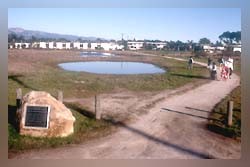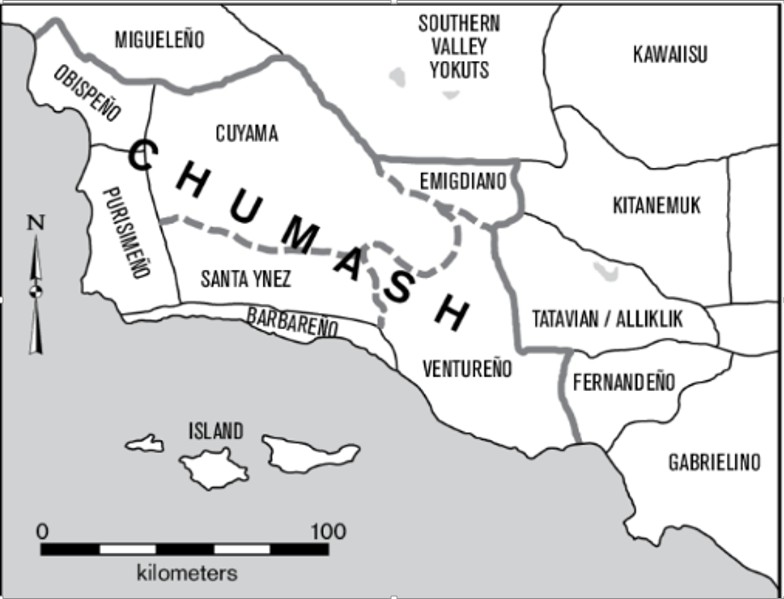Del Sol Vernal Pools
Introduction
Author-Uploaded Audio
Listen to a narration of this entry's description by Nicky Rehnberg.
Text-to-speech Audio
Recommended Time: 10 minutes
Go to the bus stop by Isla Vista Elementary School. Find the so-big-it-must-be-intentional rock that says: “Del Sol Vernal Pool Reserve.” Welcome to the beginning of a tour to one of the best places (maybe in the world?) – a place with a lot of different names. Some people will follow the rock’s lead and call it Del Sol Vernal Pool Reserve, but others may just call this whole area surrounding El Colegio Road “UCSB” or “Isla Vista.” To some of you, you may call this your bus stop. And to the Buckeye Butterfly, Pacific Treefrog, and Coyote Thistle, this is home. Maybe this is home to you, too. I definitely called it that when I lived here.
Look around. What are some of the things you see? Is anything in the pool? Sometimes you can spot a frog if you have a quick eye. You likely can hear them (I hope!). What kinds of plants do you see? You can use iNaturalist or another plant identifying app if you want to know what it is for sure, besides “tall grass.”
But then look further. What else is in this area? What kinds of buildings do you see? How big are they? Can you see the ocean? What kind of infrastructure (the physical and organizational structures that make life, as we generally live it, possible, such as roads and power poles) do you see? All of this, everything you are seeing, is part of Del Sol Vernal Pool’s ecosystem.
An ecosystem is a complex and always-changing network, a community with aspects that are biotic (“living”) and abiotic (“non-living” chemical and physical components). Much of the flora and non-human fauna surrounding it need pools like this in order to survive, and their life cycles follow the pool’s seasons. Even though they are very important habitats, 90% of California’s vernal pools have been lost due to development and climate change. This is why their protection is so important!
Images
Del Sol Vernal Pool

Map of the Chumash

Backstory and Context
Author-Uploaded Audio
Listen to a narration of this entry's description by Nicky Rehnberg.
Text-to-speech Audio
Vernal pools, like Del Sol (which means “the Sun” in Spanish), are seasonal depressional wetlands that can occur in Mediterranean climate conditions on the US West coast and in glaciated areas of the northwestern and US Midwest. They are covered with water during winter and spring (which is what “vernal” means), but they can be dry for the rest of the year. They range in size and are usually in sloping grasslands. Sometimes, especially in the US West, vernal pools can appear in networks, called vernal swales. Underneath those pools are bedrock or hard clay that keeps the water in place until it evaporates in warmer weather.
Besides vernal pools’ inherent importance as an ecosystem, the Del Sol Vernal Pools can help us understand a bit of the longer history of the land that this tour will cover, primarily known as Ellwood Mesa and Devereux Slough (and we will be calling it Ellwood Devereux during this tour).
What is the greater history of this area? I am glad you asked! It is one of my most favorite things to talk about.
If we consider history as change over time with an emphasis on when humans have been involved, we will have to start with the Chumash. All of the land UCSB is on is the unceded ancestral lands of the Chumash. They arrived in this area approximately 13,000 years ago, and they have been living here ever since. The Chumash established the villages Anisq’oyo and Kuwsa’a between 1,000 to 4,000 years before European invasion (more on this later). During this time, this area was filled with fish, birds, deer, coyotes, and other small game that used the vernal pool in order to survive.
Chumash land stretches from Malibu (a Chumash word meaning “where the mountains meet the sea”) to the Channel Islands (referencing the Santa Barbara Channel) and north to Paso Robles (Spanish for “pass of the oak trees”). One of the resources for this tour stop is a map of the broader ancestral Chumash area that unfortunately uses the California Mission System’s terminology for the different groups. It is also important to note that there are many different communities, collectives, and bands of Chumash who have existed for millennia and who are still here today.
The Chumash developed sustainable practices to make use of the natural resources in the area for thousands of years. Just a few hundred years ago, European invaders and settlers arrived and established extractive methods for cultivating and using these same resources. You may have heard of this period as "exploration,” in elementary school, but it is important to know that this was an extremely violent period of human history and not simply a matter of curious men building large ships to explore the world.
Beginning with Juan Rodriguez Cabrillo’s arrival in 1542 and later Spanish military and Catholic forces in 1769, misións (“churches”) and presidiós (“forts”) were built to establish colonies and control the estimated 2,000 Indigenous people and natural resources of the area. These institutions brought European agricultural practices -- manipulating water and soil, and introducing flora and fauna that were out of sync with the habitual and seasonal changes of the land -- to sustain their settlement and appease the Spanish Crown.
When the area fell under Mexican jurisdiction in 1821, many of these practices continued, with many European and Euro-Americans acquiring land grants. This area became known to settlers as Rancho Dos Pueblos and was granted to Nicolas A. Den by Governor Juan Alvarado in 1842. This ranching period changed the land, especially vernal pools, with livestock eating native grasses and new crops taking resources from local plants. This pool now called Del Sol disappeared altogether.
Much of the environmental conservation, preservation, and restoration of Ellwood Devereux started with its vernal pools, particularly Del Sol, under the direction of Wayne Ferren, Jr., the director of the campus Herbarium (which is now known as the Cheadle Center for Biodiversity and Ecological Restoration, also known as CCBER), beginning in the 1980s. Ferren worked with students interested in the environmental sciences to understand vernal pools and Ellwood Devereux’s ecosystem that made them possible. Because of this, I think it is a good place to think about changes in Ellwood Devereux, over time, a space and a place for much flora and fauna (including you and me)!
Exploration Questions
- What does the idea of “home” mean to you? How do you relate the space you are standing in now to your idea of home?
- In your notebook, sketch from a bird’s eye view how you imagine this land where you are standing has changed over the past thousand years during Chumash habitation, Spanish colonial settlement, ranching practices under Mexican rule, the construction of the UC campus, and restoration efforts during recent years.
- How much water can you see in the vernal pool? What factors do you think have resulted in its appearance (e.g. recent weather, season, ecological management, climate change)?
- Take three deep breaths in and out. Pick any two scents that you can smell and write about where you think they come from. How do they interact with one another in this place?
- What is a “reserve”? What is being reserved in this place? Why? For whom?
Sources
Dartt-Newton, Deana. Negotiating the Master Narrative: Museums and the Indian/Californio Community of California's Central Coast. PhD diss. (University of Oregon, 2009), 24.
Environmental Protection Agency, https://www.epa.gov/wetlands/vernal-pools
Gamble, Lynn H. The Chumash World at European Contact: Power, Trade, and Feasting among Complex Hunter-Gatherers, (Berkeley: University of California Press, 2008), 86.
Henn, Brenna M., et al. “The Great Human Expansion.” PNAS, National Academy of Sciences of the United States of America, 30 Oct. 2012, www.pnas.org/content/109/44/17758.
Isla Vista Free Press, 4, Sept. 17-29, 1987.
Santa Barbara Museum of Natural History, www.sbnature.org/collections-research/anthropology/chumash-life/.
http://www.ivparks.org/vernal-pools/
https://native-land.ca/maps/territories/chumash/
